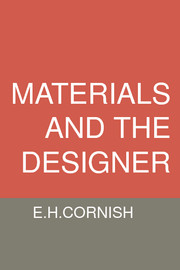Book contents
- Frontmatter
- Contents
- Preface
- Introduction
- 1 The impact of design on manufacturing industry
- 2 Expertise required for the design process
- 3 An introduction to materials
- 4 Properties of metals and alloys
- 5 Properties of ceramics
- 6 Properties of polymers
- 7 Properties of composites
- 8 Materials' performance in service
- 9 Finishes and coatings as protective systems
- 10 Materials reliability and service life
- 11 Factors controlling the selection of substitute materials
- 12 Material forming processes and design
- 13 Sources of information on materials
- 14 Standards and materials
- References
- Bibliography
- Index
12 - Material forming processes and design
Published online by Cambridge University Press: 05 August 2012
- Frontmatter
- Contents
- Preface
- Introduction
- 1 The impact of design on manufacturing industry
- 2 Expertise required for the design process
- 3 An introduction to materials
- 4 Properties of metals and alloys
- 5 Properties of ceramics
- 6 Properties of polymers
- 7 Properties of composites
- 8 Materials' performance in service
- 9 Finishes and coatings as protective systems
- 10 Materials reliability and service life
- 11 Factors controlling the selection of substitute materials
- 12 Material forming processes and design
- 13 Sources of information on materials
- 14 Standards and materials
- References
- Bibliography
- Index
Summary
The product designer could not exercise his profession properly without an extensive knowledge of the processes by which materials are transformed into products. Through this knowledge of processes he can optimise the advantages stemming from them, and avoid at least the greatest of their limitations. The purpose of this chapter, therefore, is to advise the designer of some more recent methods of materials forming, which he may care to study further and subsequently exploit.
A brief reminder of the well-established orthodox forming routes for metals and polymers is given in the next two Tables. Table 12.1 lists some common methods for forming metals, being categorised according to whether the metal being worked upon is molten, heated, or operated upon at essentially a low (room) temperature. Table 12.2 with common forming methods for shaping plastics, lists a few processes which depend upon liquid reactive precursors before a final solid part is obtained, and also mentions methods requiring preformulated material such as moulding granules, stock shapes such as sheet, rod and tube, or simply liquids or solutions.
This chapter considers in turn recent production processes for metals, polymers, composites and ceramics, and concludes with a brief note of some modern techniques with more general application.
Metals
Extending in considerable detail the information of Table 12.1, Phelan and Wyatt (1981) provide a useful summary of specific variants of the main metal forming processes comprising sand casting, die casting, investment casting, centrifugal processes, powder metallurgy and even the deposition of metal layers from fluids.
- Type
- Chapter
- Information
- Materials and the Designer , pp. 230 - 240Publisher: Cambridge University PressPrint publication year: 1987



